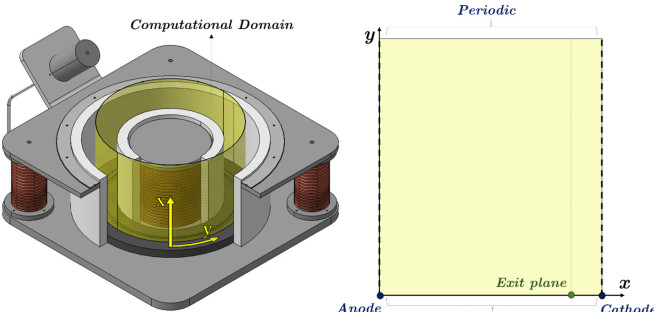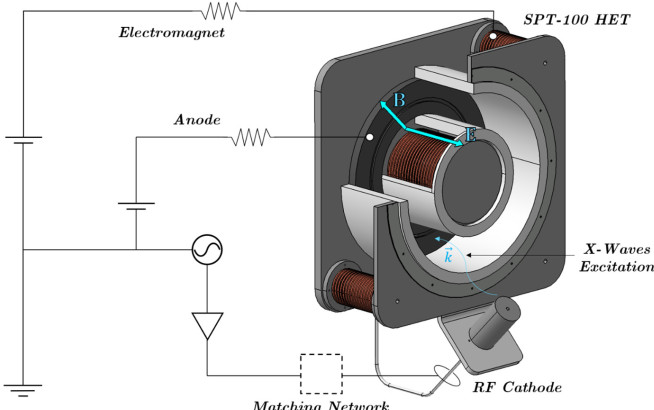Motivation and background
In this study, we investigate the use of radiofrequency (RF) excitation in single-stage Hall Effect Thrusters (HETs) as a method to increase the performance and competitiveness of the technology. The in-channel plasma properties and the orientation of the magnetic and electric fields within HETs makes them suitable for exciting the so-called Extraordinary Waves (X-Waves), which travel longitudinally throughout the channel and can effectively deposit energy in the plasma, enhancing the electron energy and, consequently, the density of the plasma upstream of the acceleration region. The impact of RF excitation on the discharge characteristics is investigated with the use of fully kinetic Particle-in-Cell (PIC) simulations for an SPT-100 device.
Approach

An in-house pseudo 2D Particle-In-Cell (PIC) code developed at the Imperial Plasma Propulsion Laboratory called PlasmaSim (Figure 1) is validated against the Russian thruster SPT-100 and adapted to be used as a computational tool to analyze plasma-wave interactions.
The code is validated against the SPT-100 experimental results, without plasma excitation, and the agreement is found to be within 10% of discrepancy across all measured performance parameters - thrust, specific impulse and power input. The obtained in-channel properties’ distributions are also validated against literature and experimental measurements. Having established the physical consistency of the simulation, PlasmaSim is used as a tool to investigate the impact of RF excitation on the discharge characteristic of the SPT-100 device.
First, it is proposed how this approach can be implemented in a real space mission, identifying the use of a RF cathode as the most suitable excitation source of X-Waves (Figure 2). Subsequently, a range of frequencies is found as promising candidates for performance augmentation of the thruster, based on theoretical hot and cold approximations to the plasma.
Obtained and/or anticipated results

Using the methods outlined in the previous section, the influence of RF excitation on the thruster is investigated. The macroscopic performance parameters as well as the in-channel plasma properties are compared to the baseline case without RF augmentation. The main objective is to find a suitable combination of power and frequency that results in an overall improvement to the thrust, specific impulse and total efficiency considering the additional power supplied for the RF heating and any other possible loss mechanisms. A firm baseline of computational results is obtained to further develop this topic experimentally, envisioned as the next stage of this research activity.
Relevant publications
- JM. Tejeda, M. Reza, F. Faraji and A.Knoll, “Performance enhancement of Hall Effect Thrusters using radiofrequency excitation,” Acta Astronautica, Vol. 194, 2022, pp. 145–161. http://dx.doi.org/10.1016/j.actaastro.2022.01.033
- JM. Tejeda and A.Knoll, “A Water Electrolysis Hall Effect Thruster Computational Model with Radiofrequency Excitation,” 37th International Electric Propulsion Conference, IEPC-2022-313, Massachusetts Institute of Technology, Cambridge, MA, USA, 2022. Full text and presentation available on ResearchGate.